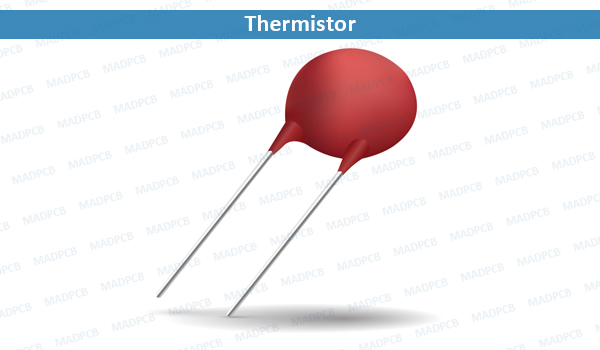What’s A Thermistor?
A Thermistor is a type of resistor whose resistance is strongly dependent on temperature, more so than in standard resistors. The word is a combination of thermal and resistor. The relationship between a thermistor’s temperature and its resistance is highly dependent on the materials from which it’s compromised.
Thermistors are made up of metallic oxides, binders and stabilizers, pressed into wafers and then cut to chip size, left in disc from, or made into another shape. The precise ratio of the composite materials governs their resistance/temperature “curve”. Manufacturers typically control this ratio with great accuracy, since it determines how the thermistor will function.
Thermistors are widely used as inrush current limiters, temperature sensors (negative temperature coefficient or NTC type typically), self-resetting overcurrent protectors, and self-regulating heating elements (positive temperature coefficient or PTC type typically). An operational temperature range of a thermistor is dependent on the probe type and is typically in between −100 °C (−148 °F) and 300 °C (572 °F).
Types of Thermistor
Thermistors are available in 2 types:
- NTC (negative temperature coefficient)
- PTC (positive temperature coefficient)
NTC thermistor is commonly used to measure temperature.
Thermistor Configurations
Thermistors are available in several common configurations. The three most frequently employed are the hermetically sealed flexible thermistor (HSTH series), the bolt-on/washer type and the self-adhesive surface-mount style.
- HSTH Thermistors are completely sealed within PFA (plastic polymer) jackets to protect the sensing element from moisture and corrosion. They can be used to measure the temperature of an array of liquids ranging from oils and industrial chemicals to foods.
- Thermistors with bolt- or washer-mounted sensors can be installed into standard-sized threaded holes or openings. Their small thermal mass enables them to respond to temperature changes rapidly. They’re used in many applications, including household appliances, water tanks, pipes and equipment casings.
- Surface-mounted thermistors come with adhesive exteriors that can easily be stuck in place on flat or curved surfaces. They can be removed and re-applied and have several commercial and industrial applications.
Temperature Range, Accuracy and Stability
Thermistors are highly accurate (ranging from ± 0.05°C to ± 1.5°C), but only over a limited temperature range that is within about 50°C of a base temperature. The working temperature range for most thermistors is between 0°C and 100°C. Class A thermistors offer the greatest accuracy, while Class B thermistors can be used in scenarios where there’s less need for exact measurement. Once the manufacturing process is complete, thermistors are chemically stable and their accuracy does not change significantly with age.
Common Applications for Thermistors
Thermistors are employed in a broad array of commercial and industrial applications to measure the temperature of surfaces, liquids and ambient gasses. When sheathed in protective probes that can be reliably sanitized, they’re used in the food and beverage industries, in scientific laboratories and in R&D. Heavy-duty probe mounted thermistors are suitable for immersion in corrosive fluids, and can be used in industrial processes, while vinyl-tipped thermistor mounts are used outdoors or for biological applications. Thermistors are also available with metal or plastic cage-style element covers for air temperature measurement.

